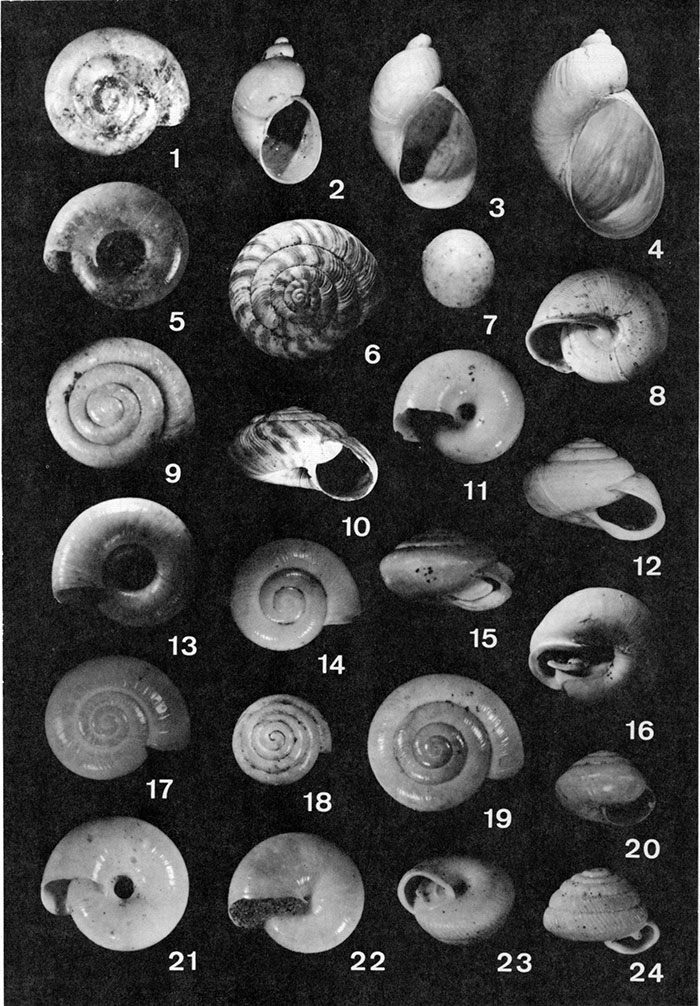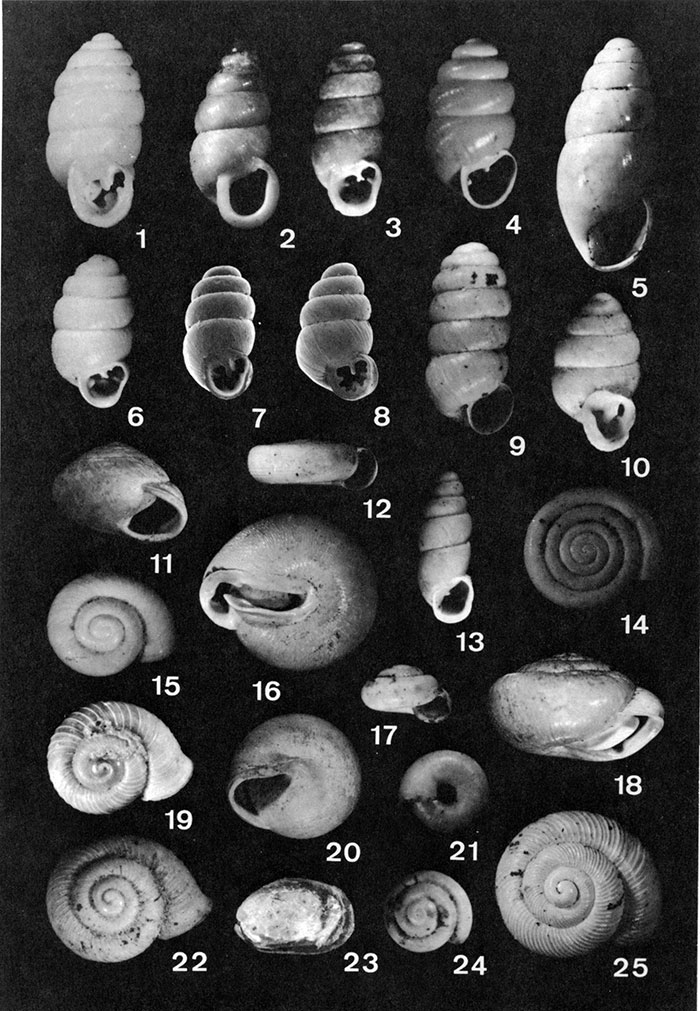Previous--Buried Valleys
Mobil Research Laboratory, Dallas, Texas
Many of the Missouri loess deposits occurring in proximity to the Missouri River floodplain contain abundant and diverse Pleistocene pulmonate gastropod faunas (Plates 1 and 2). The most abundant and well-preserved faunas occur in deposits of calcareous loess developed on the eastern banks in areas where the river flows primarily north-south. In areas where the river flows east-west the loess is typically thin and unfossiliferous.
Faunas were collected by channel-sampling through the entire thickness of each outcrop. This consisted of taking 1 cubic foot of material from each 2-foot interval. These samples typically yielded over 1,000 specimens each.
A bioassociational analysis (Valentine and Mallory, 1965) was performed to determine whether or not faunal groupings could be derived which would be useful for environmental and/ or stratigraphic interpretations. This analysis produced two major faunal associations that are primarily related to regional climatic trends and do not appear to be restricted to any specific stratigraphic horizons. It has been proposed that climatic changes associated with the various stages of loess deposition resulted in regional alteration of the species content of the gastropod populations living during those times such that they could be used for biostratigraphic correlation of the loess (Leonard and Frye, 1960). This was not found to be the case in Missouri. Although certain gastropod species tend to occur in greater abundance in either the Bignell or Peoria loess, their occurrence in one of these deposits does not exclude them from occurring in the other.
One of the faunal associations mentioned above is typical of an uplands forest environment such as exists today in many parts of Missouri and the other is representative of a prairie, prairie-forest border situation as in eastern Kansas and parts of western Missouri. The most common faunal elements of these two fossil associations are as follows:
| Prairie-Forest Ecotone |
Deciduous Forest |
|---|---|
| Anguispira alternata Cionella lubrica Gastrocopta armifera G. contracta G. holzingeri C. pentodon C. procera Haplotrema concavum Hawaiia minuscula Helicodiscus parallelus H. singleyanus Pupoides albilabris Stenotrema hirsutum S. leai Vallonia parvula |
Carychium exile canadense Discus cronkhitei D. shimeki Euconulus fulvus Hendersonia occulta Nesovitrea electrina Punctum minutissimum Strobilops labyrinthica Succinea gelida S. grosvenori S. ovalis Triodopsis multilineata Vertigo gouldi hubrichti V. modesta |
The uplands forest fauna commonly occurs in samples collected throughout Missouri and from all the stratigraphic intervals. The prairie, prairie-forest border fauna occurs more often in samples collected from the western part of the state and in samples collected from the younger loesses, e.g., Bignell. These relationships were further substantiated by calculating the species diversity (Beerbower and Jordan, 1969) and a habitat-moisture index for all the samples.
The habitat-moisture index calculated from the species content of each sample and based on the habitat preferences of living representatives of the species indicates increasing aridity in a westerly direction across Missouri during latest Wisconsinan. This trend existed during Woodfordian time, increased in intensity during the Valderan, and reached its peak during the altithermal period when many of the extensive deciduous forests which developed earlier in the Wisconsinan when the climate was cooler and more moist than today gave way to grasslands and prairies which have since remained as relicts due to the decline in temperature and increase in available moisture since that time. Many of the samples, especially those of Peoria loess, contain gastropod species which have modern representatives that are restricted to more northern latitudes today, e.g., Carychium exile, Discus cronkhitei, and Vallonia gracilicosta, indicating that at least during Woodfordian time the climate in Missouri was somewhat cooler than today. Also, in samples of Peoria and Bignell loess the species diversity increases toward the west and is a reflection of the increased occurrence of the grasslands fauna coexisting with the uplands forest fauna in this direction. In addition, the grasslands assemblage composes a larger proportion of the fauna in samples of Bignell than of Peoria loess (Pauken, 1969).
In consideration of the above discussion, I propose that from late Pleistocene to present, an upland forest-prairie ecotone has existed in Missouri and has shifted east and west in response to changing climate. The record of these changes has been preserved in detail by the gastropod faunas trapped in loess deposits formed during this interval.
Common Pleistocene pulmonate gastropods occurring in the loess deposits of western Missouri.
Figures 1, 5--Helicodiscus singleyanus (Pilsbry). 1, Apical view; 5, Umbilical view. XlB
Figure 2--Succinea gelida (Baker). 2, Apertural view. X 5
Figure 3--Succinea grosvenori Lea. 3, Apertural view. X4
Figure 4--Succinea ovialis Say. 4, Apertural view. X3
Figures 6, 10--Anguispira alternata (Say). 6, Apical view; 10, Apertural view. X1.B
Figure 7--Snail egg. 7. XIS
Figures 8, 12--Triodopsis multilineata (Say). 8, Umbilical view; 12, Apertural view. X 1.B
Figures 9, 13--Hawaiia minuscula (Binney). 9, Apical view; 13, Umbilical view. X IB
Figure
Figures 11, 14--Nesovitrea electrina (Gould). 11, Umbilical view; 14, Apical view. X11
Figures 15, 16--Stenotrema leai (Binney). 15, Apertural view; 16, Umbilical view. X5
Figures 17, 22--Nesovitrea indentata (Say). 17, Apical view; 22, Umbilical view. X 11
Figures 18, 20--Euconulus fulvus (Muller). 1B, Apical view; 20, Apertural view. X 11
Figures 19, 21--Zonitoides arboreus (Say). 19, Apical view; 21, Umbilical view. X 11
Figures 23, 24--Strobilops labyrinthica (Say). 23, Umbilical view; 24, Apertural view. X 11

Common Pleistocene pulmonate gastropods occurring in the loess deposits of western Missouri.
Figure l--Gastrocopta armijera (Say). 1, Apertural view. XlI
Figure 2--Pupoides albilabris Adams. 2, Apertural view. XlI
Figure 3--Gastrocopta procera (Could). 3, Apertural view. XlI
Figure 4--Vertigo modesta (Say). 4, Apertural view. X 1B
Figure 5--Cionella lubrica (Muller). 5, Apertural view. XlI
Figure 6--Vertigo gouldi hubrichti Pilsbry, 6, Apertural view. X1B
Figure 7--Gastrocopta holzingeri (Sterki). 7, Apertural view. X23 Scanning electron micrograph
Figure 8--Gastrocopta pentodon (Say). 8, Apertural view. X23 Scanning electron micrograph
Figure 9--Columella alticola (Ingersoll). 9, Apertural view. X1B
Figure 10--Gastrocopta contracta (Say). 10, Apertural view. X1B
Figures 11, 20--Hendersonia occulta (Say). 11, Apertural view; 20. Umbilical view. X5
Figures 12, 14--Helicodiscus parallelus (Say). 12, Apertural view; 14, Apical view. X Ll
Figure 13--Caruchium exile canadense Clapp. 13, Apertural view. XlB
Figure 15--Vallonia perspectiva Sterki. 15, Apical view. X 16
Figures 16, 18--Stenotrema hirsutum (Say). 16, Umbilical view; 18, Apertural view. X5
Figures 17, 21, 24--Punctum minutissimum (Lea). 17, Apertural view; 21, Umbilical view; 24, Apical view. X16
Figure 19--Vallonia parvula Sterki. 19, Apical view. X16
Figure 22--Vallonia gracilicosta Reinhardt. 22, Apical view. X16
Figure 23--Deroceras laeve (Muller). 23, Apical view. X 11

Beerbower, J. R., and Jordan, D., 1969, Application of information theory to paleontologic problems: Taxonomic diversity: Jour. Paleontology, v. 43, no. 5, p. 1184-1198.
Leonard, A. B., and Frye, J. C., 1960, Wisconsin molluscan faunas of the Illinois Valley region: Illinois State Geol. Survey Circ. 304, 32 p.
Pauken, R. J., 1969, A population study of the Pleistocene molluscan faunas in the loess of the Missouri River basin in Missouri: Unpub. Ph.D. dissertation, Univ. Missouri at Columbia, 192 p.
Valentine, J. W., and Mallory, R., 1965, Recurrent groups of bonded species in mixed death assemblages: Jour. Geol., v. 73, no. 5, p. 6B3-70l.
Previous--Buried Valleys
Kansas Geological Survey
Comments to webadmin@kgs.ku.edu
Web version Feb. 19, 2013. Original publication date 1971.
URL=http://www.kgs.ku.edu/Publications/Bulletins/SDP53/pauken.html